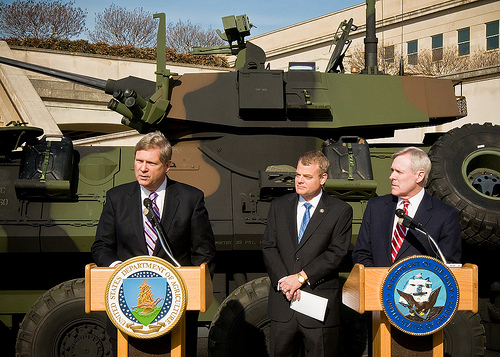Agriculture Secretary Tom Vilsack joined Secretary of the Navy Ray Mabus at the Pentagon this morning to sign a key Memorandum of Understanding (MOU) to encourage the development of advanced biofuels and other renewable energy systems. The event, held outside the building to showcase a light armored vehicle of the type capable to accommodate fuel from renewable energy sources, initiates a long term commitment from both departments to work in consort to secure the strategic energy future of the United States. It also is intended to create a more “nimble and effective” fighting force and provide renewable resources that protect the planet from destabilizing climate changes.USDA, through Rural Development, the Farm Service Agency and the Research, Education and Economics mission, will work with the Navy and Marines to support President Obama’s initiative to make the United States a global leader in developing a renewable energy economy, reducing energy consumption from fossil fuels and increasing energy production from renewable energy sources.
The Secretaries were joined at the event by a number of dignitaries, including North Carolina Congressman Mike McIntyre, a member of the House Agriculture Committee and the House Armed Services Committee. The Congressman noted that the renewable fuel production capacity of America’s farmers combines the “strength of our heartland” with our military in a spirit of innovation that sustains our Nation.
In his remarks, Secretary Mabus said that President Obama’s declaration that energy reform is a “national security imperative” underscores the necessity for the government to address the issue in bold fashion. “The stakes are clear, the stakes are high and as our President said at the Climate Summit in Copenhagen, we choose bold action over inaction.” The Secretary said that the military uses 90 percent of the energy consumed by the Federal government. The Navy alone has 50,000 non-tactical vehicles and a goal of cutting petroleum use by those vehicles in half by 2015 by phasing in hybrid, flex-fuel and electric models.
Secretary Vilsack began his remarks by saying it was an honor to be in the presence of “those who serve us in uniform.” He thanked the Secretary for the security afforded to him and his staff during a recent visit to Afghanistan and he noted the tremendous response being mounted by the Military, including the Navy and Marines, in earthquake-damaged Haiti.
Secretary Vilsack noted that in addition to the National Security, clean energy and Environmental factors, the MOU creates an opportunity to “Use the resources of USDA, including research capability, to create second and third generation biofuels for Military use” while also establishing “an enormous jobs generator.” The Secretary said that farmers will sell raw materials to be converted to biofuels to processing facilities that still need to be “designed, built and operated.” “This MOU is about creating jobs, a cleaner environment and a secure America,” all priorities of the Obama administration.
During the actual signing ceremony, Secretary Vilsack used a pen made from renewable materials (corn cob) from Iowa. Vilsack, a former Governor of Iowa, presented the pen to Secretary Mabus, a former Governor of Mississippi.
 Seated, (L-R) Secretary Tom Vilsack and Secretary Ray Mabus sign the MOU between the Department of Agriculture and the Navy. Looking on are Agriculture Under Secretary for Rural Development Dallas Tonsager, Congressman Mike McIntyre and Roger Natsuhara, Assistant Secretary of the Navy, Installations and Environment (Acting).
Seated, (L-R) Secretary Tom Vilsack and Secretary Ray Mabus sign the MOU between the Department of Agriculture and the Navy. Looking on are Agriculture Under Secretary for Rural Development Dallas Tonsager, Congressman Mike McIntyre and Roger Natsuhara, Assistant Secretary of the Navy, Installations and Environment (Acting).
 Secretary Vilsack, Congressman McIntyre and Secretary Mabus answer reporters questions while standing in front of a light armored vehicle of the type capable to accommodate fuel from renewable sources.
Secretary Vilsack, Congressman McIntyre and Secretary Mabus answer reporters questions while standing in front of a light armored vehicle of the type capable to accommodate fuel from renewable sources.
 Secretary Vilsack presents a pen, made from a corn cob, to Secretary Mabus. The pen is from Iowa, where Vilsack served as Governor prior to his appointment to USDA by . President Obama
Secretary Vilsack presents a pen, made from a corn cob, to Secretary Mabus. The pen is from Iowa, where Vilsack served as Governor prior to his appointment to USDA by . President Obama
Submitted by Wayne Maloney, Office of Communications








